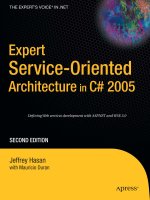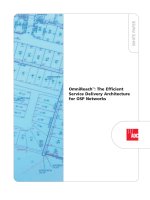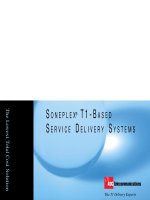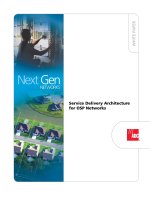FTTN Service Delivery Option
Bạn đang xem bản rút gọn của tài liệu. Xem và tải ngay bản đầy đủ của tài liệu tại đây (1.07 MB, 4 trang )
Although FTTP is receiving a great deal of attention for delivering today’s
bandwidth-hungry triple-play services to the home, many service providers are
opting for a fiber-to-the-node (FTTN) access solution. FTTN takes advantage of
existing copper infrastructure to provide a cost effective alternative – and ADC
has developed an entire portfolio of FTTN service delivery solutions.
These service delivery solutions cover numerous scenarios and situations,
including passive stand-alone architectures and active integrated solutions
whereby the service delivery frame is actually embedded into an active cabinet.
There is even a “combo” solution that provides FTTN delivery using one side of
the cabinet with the provision to plug in 1x32 optical splitters on the opposite
side for a fast future upgrade to an FTTP cabinet network architecture. This is a
unique single cabinet solution for deploying FTTN today with a migration route
to FTTP tomorrow.
Each solution provides the technicians with a consistent “look and feel”
approach to wiring within each cabinet, making it easy to quickly identify key
components and ports. These solutions offer monitor “look-in, look-out” testing
capabilities that help technicians quickly isolate any potential network problems.
Like FTTP, there are considerations and challenges to deploying successful FTTN
solutions. There is no “one size fits all” solution when transforming the
traditional switched approach network into a high-speed, high-capacity
broadband network.
Challenges and Considerations
FTTN Service Delivery Option
Challenges to FTTN
The first challenge facing FTTN deployers is the need to
“resectionalize” the distribution areas (DA). Today,
service providers are providing regular DSL or ADSL
services to customers via a digital loop carrier (DLC)
feeding through a cross box with a loop length, in some
cases, that can have a loop length of up to 12,000 feet.
But the introduction of VDSL or ADSL2/ADSL2+
technologies is now limiting distribution area (DA) loop
length distances to between 3000 and 5000 feet.
Another example is the 18,000 foot CO-fed distribution
area. The copper outside plant (OSP) that serves
customers within this DA will have to be resectionalized
to shorten all loops to within 3000 to 5000 feet. In this
CO DA, the digital subscriber line access multiplexer
(DSLAM) may require to be replaced or require an
upgrade to support the new services. Additionally, the
CO DA will have to be resectionalized by using existing
plant and rearranging it to create smaller loop links. In
essence, the CO will only serve an area approximately
3000 to 5000 feet from its location.
At the remote terminals (RTs), the same challenges must
be addressed. Depending on whether each RT is copper
or fiber fed, the distribution areas, which were probably
12,000 feet, must now be rearranged to support
customers within a 3000- to 5000-foot area.
When providing new services, there are also the low
density areas – those beyond 5000 feet from the last
cross box – that must be considered. These are areas
that traditionally “do not qualify” for new services –
mainly due to the cost involved with distributing services
to these sparsely populated areas. However, at some
point, providers must acknowledge the demand for the
same new services they are providing to customers in
more densely populated areas. Thus, when
reconstructing the FTTN network for new services, this is
a valid consideration.
Low density areas may be the most challenging part of
deploying the FTTN network. New remote terminal
installations will be required to reach these customers, as
well as additional fiber and cabinets. Additionally, pair
counts may not be available for bonded DSL strategies.
Sub-dividing the DA
Sub-dividing, or resectionalizing, the DA will be a major
consideration as service providers reduce coverage areas
from the traditional 12,000 feet to smaller loops of 3000
to 5000 feet. Different requirements in different areas of
the network will demand customized solutions. For
example, an existing cross-box will now be limited to
5000 feet of coverage, making it necessary to add
additional cabinets at the edge of the 5000-foot
boundary to service customers beyond that limit.
Other challenges include finding ways to accommodate
various existing designs of the OSP portion of the
network. Subdivisions may require different size
solutions, depending on customer density and distances.
Right-of-way issues must be considered where new
cabinet placements are required. The existing fiber
feeder distribution interconnect (FDI), also known as a
cross-box, may have no spare binding post to support a
direct terminated method for delivering new service.
Providers must also consider the fact that not all
customers will want to switch from basic DSL services,
such as from ADSL service to ADSL2+.
Service delivery challenges
There are also several service delivery challenges
associated with this new FTTN broadband technology.
The most significant challenge is in pair bonding.
Although pair bonding doesn’t actually refer to physically
tying two pairs together to provide more copper, it
accomplishes a similar objective. It enables the electronic
bonding, inside the DSLAM, of two output DSLAM ports
to provide twice the bandwidth. However, for successful
pair bonding, there must be two continuous copper pairs
available to the customer premises and the service
delivery platform, such as the cross-box or interface,
must support pair bonding.
It is common to run voice over the low frequency part of
the circuit, while running data over the high frequency
portion. This enables voice and data to run over a single
copper pair. The same can be accomplished for the new
DSL services. A second pair can be run into the home and
electronically bonded back to the DSLAM terminal to
provide twice the capacity to the customer plus a voice
channel. However, pair bonding presents new challenges
to the phone companies.
For example, to deploy these adjunct DSLAMs – such as
placing a small cabinet next to an existing cross-box and
injecting the services – there may not be enough spare
binding posts inside the cross-box. For 100 circuits of
DSLAM, only 200 pairs of binding posts are available
required in a traditional cross box. This could make pair
bonding a complicated and expensive initiative.
Provisioning new ADSL, ADSL2+, or UDPSL2 services at
places where two pairs are required may not always be
possible. Some homes may not have a second
continuous pair available. Thus, service providers will end
up rolling customers from their existing platform to the
new platform that is closer to the subscriber – all at
FTTN Service Delivery Option Challenges and Considerations
Page 2
FTTN Service Delivery Option Challenges and Considerations
Page 3
additional expense. There may also be multiple voice-
grade lines needed if pair bonding is used to create
necessary additional wiring requirements.
Other considerations include having clean copper pairs
– there cannot be any bridge taps on the line. Load
coils or other means of stretching POT service must
also be eliminated. Today’s new services require a clean
copper plant.
Solutions? You bet!
ADC offers FTTN solutions that address copper pair
bonding challenges and provide streamlined service
delivery alternatives to binding post issues within existing
cross-boxes. The company’s passive service delivery
solution can operate as a stand-alone unit or be
integrated into active deep fiber broadband cabinets for
easily resectionalizing the existing DA. New deep fiber
broadband cabinets are available in several sizes that
address DA rezoning. These cabinets make possible a
copper service delivery platform that manages pairs easily
and supports pair bonding. Every ADC product provides
the same look and feel – as well as monitor “look-in,
look-out” testing capability – to give technicians a more
reliable, user-friendly CAT-5 connection.
There are multiple approaches to deploying FTTN, so
multiple solutions should be available. One approach is
using passive cabinets to upgrade DSLAMs at the remote
terminal or where an existing cross box may lack
capacity. There will also be a need for medium and small
integrated cabinets – active, fiber-fed units for
resectionalizing the existing network infrastructure.
At the CO, the objective is to serve all customers within
3000 to 5000 feet. Copper-fed remote terminals, with or
without DSLAMs, can be used to resectionalize the DA to
serve customers within 5000 feet. Fiber-fed remote
terminals, with or without DSLAMs, that are already
present in the network can also service a 5000 foot area.
Finally, new DAs will require brand new solutions, such as
an all-in-one fiber- fed broadband cabinet with built-in
copper distribution.
A new FTTN architecture is shown in the figure below
using one of ADC’s OmniReach FTTN2P solutions. This
solution enables service providers to migrate to FTTP or
offer both FTTP and VDSL/ADSL2+ out of the same
cabinet. All FTTP components are modular and can be
added at a later date.
Central Office
DSLAM
(Active)
Cabinet with
ADC Fiber
and Copper
Solutions
Feeder OSP
Cable from CO
Fiber
Distribution
Hub
Splice Cases
Hybrid
(Passive)
FTTN2P
Cabinet
DSLAM (Active)
Cabinet with
ADC Fiber and
Copper Solutions
ADC DSL
Cross-Connect
Cabinet
FTTN Architecture Diagram
FTTP migration and DSLAM protection
Each DSLAM input/output and feeder/distribution
section in ADC’s NCX Passive Service Delivery
Cabinet has a unique monitor look-in/look-out
testing capability. This feature enables technicians
to easily turn up services and provide
troubleshooting operations.
One of the keys to ADC’s FTTN solution is its
ComProtect
™
protection components. The voice
circuit is actually run into the input block through
the ComProtect unit to protect the DSLAM circuit.
It is then run out of the DSLAM through the
input/output block to protect the output, and
then tied directly to the distribution pair.
ComProtect replaces the 5-pin protector, and
saves a great deal of space in the cabinet.
The ComProtect unit provides over-voltage and
over-current protection for the network element.
A key feature of the ComProtect solution is to
provide crossconnect capability and protection in a
single footprint, thus reducing space in the
cabinets. The unit passes or exceeds all Telcordia
requirements for protection devices.
ADC provides two basic FTTN application
technologies. The first one is a cabinet that
combines the cross-box and DSL inputs/outputs
into one footprint. The other is the distribution
intercept (DI) that provides a built-in cut-through
for the terminal block.
Using a DI application offers a low-cost, quick-to-
market solution for operating companies. With this
application, the existing dial tone services pass
through a special terminal block that simply relays
the service out of the cabinet. When a customer
requests DSL services, the technician only has to
run a four-wire crossconnect jumper to deliver
voice and DSL. The DI application is spliced into the
network downstream from existing cross boxes
and RT sites. This means there is no investment
required to existing plant. Simply place the new
broadband cabinet in a location within 3000 to
5000 feet of the subscribers, half tap into the OSP
plant, and turn up the new broadband services.
FTTN, FTTP or Both?
As service providers make major decisions
regarding the most cost effective, reliable method
of delivering today’s new voice, video and data
services to customers, both FTTP and FTTN
solutions should be thoroughly investigated.
Individual circumstances surrounding each
individual deployment will dictate how far to push
fiber towards the customer premises.
For greenfield deployments, the cost parity
between copper and fiber has made FTTP a viable
choice. However, overbuilding existing networks
with pure fiber may prove to be cost-prohibitive
for many providers, making FTTN a very attractive
alternative solution – particularly if it provides an
easy migration to FTTP in the future. Whatever
the choice, ADC offers custom products that
adapt to any deployment scenario to provide the
most reliable, flexible, and cost effective long-
term solutions.
ADC Telecommunications, Inc., P.O. Box 1101, Minneapolis, Minnesota USA 55440-1101
Specifications published here are current as of the date of publication of this document. Because we are continuously
improving our products, ADC reserves the right to change specifications without prior notice. At any time, you
may verify product specifications by contacting our headquarters office in Minneapolis. ADC Telecommunications,
Inc. views its patent portfolio as an important corporate asset and vigorously enforces its patents. Products or
features contained herein may be covered by one or more U.S. or foreign patents. An Equal Opportunity Employer
101770AE 11/06 Revision © 2005, 2006 ADC Telecommunications, Inc. All Rights Reserved
Web Site: www.adc.com
From North America, Call Toll Free: 1-800-366-3891 • Outside of North America: +1-952-938-8080
Fax: +1-952-917-3237 • For a listing of ADC’s global sales office locations, please refer to our web site.
WHITE PAPER









